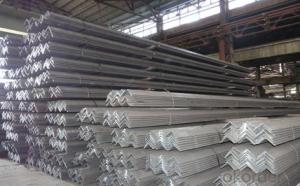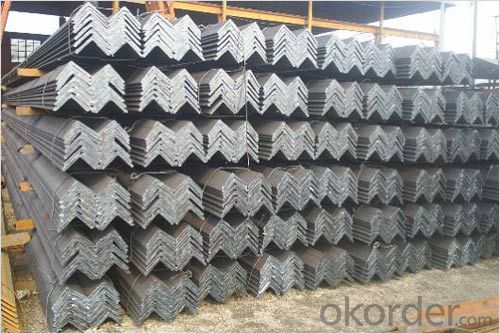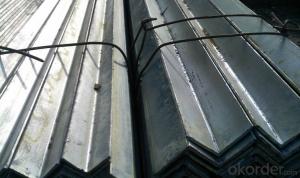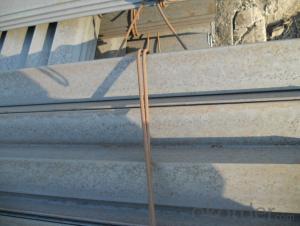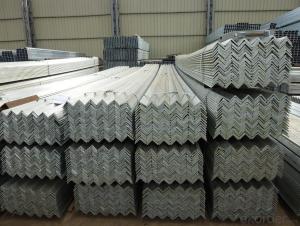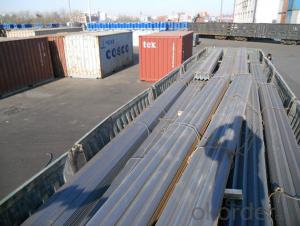Equal Angle Steel for Furniture and Super-market Shelf for Sale
- Loading Port:
- Tianjin
- Payment Terms:
- TT or LC
- Min Order Qty:
- 30 m.t.
- Supply Capability:
- 37000 m.t./month
OKorder Service Pledge
OKorder Financial Service
You Might Also Like
Product Description:
OKorder is offering Equal Angle Steel for Furniture and Super-market Shelf for Sale at great prices with worldwide shipping. Our supplier is a world-class manufacturer of steel, with our products utilized the world over. OKorder annually supplies products to European, North American and Asian markets. We provide quotations within 24 hours of receiving an inquiry and guarantee competitive prices.
Product Applications:
Equal Angle Steel for Furniture and Super-market Shelf for Sale are ideal for structural applications and are widely used in the construction of buildings and bridges, and the manufacturing, petrochemical, and transportation industries.
Product Advantages:
OKorder's Equal Angle Steel for Furniture and Super-market Shelf for Sale are durable, strong, and resist corrosion.
Main Product Features:
· Premium quality
· Prompt delivery & seaworthy packing (30 days after receiving deposit)
· Corrosion resistance
· Can be recycled and reused
· Mill test certification
· Professional Service
· Competitive pricing
Packaging & Delivery:
Packaging Detail: products are packed in bundle and then shipped by container or bulk vessel, deformed bar is usually naked strapping delivery, when storing, please pay attention to moisture proof. The performance of rust will produce adverse effect.
Each bundle weight: 2-3MT, or as required
Payment term: TT or L/C
Delivery Detail: within 45 days after received advanced payment or LC.
Label: to be specified by customer, generally, each bundle has 1-2 labels
Trade terms: FOB, CFR, CIF
FAQ:
Q1: Why buy Materials & Equipment from OKorder.com?
A1: All products offered byOKorder.com are carefully selected from China's most reliable manufacturing enterprises. Through its ISO certifications, OKorder.com adheres to the highest standards and a commitment to supply chain safety and customer satisfaction.
Q2: How do we guarantee the quality of our products?
A2: We have established an advanced quality management system which conducts strict quality tests at every step, from raw materials to the final product. At the same time, we provide extensive follow-up service assurances as required.
Q3: How soon can we receive the product after purchase?
A3: Within three days of placing an order, we will begin production. The specific shipping date is dependent upon international and government factors, but is typically 7 to 10 workdays.
Images:
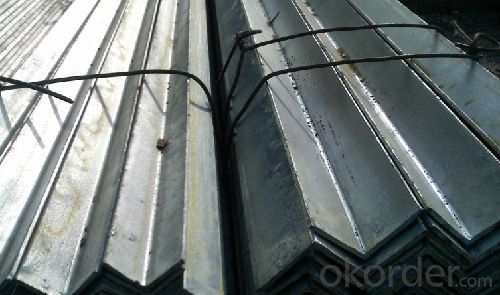
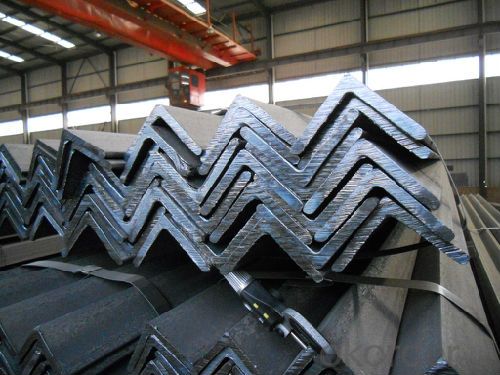
- Q: What is the maximum load capacity of a steel angle?
- The maximum load capacity of a steel angle depends on various factors such as the dimensions, thickness, and quality of the steel angle. It is essential to consult engineering specifications or contact a structural engineer to determine the specific maximum load capacity for a particular steel angle.
- Q: Can steel angles be used for support columns in building construction?
- Yes, steel angles can be used for support columns in building construction. Steel angles provide structural support and stability due to their high strength and rigidity. They are commonly used in construction projects for various purposes, including supporting beams and columns.
- Q: How do you straighten a bent steel angle?
- In order to straighten a bent steel angle, a few tools and equipment will be necessary. Below is a step-by-step guide to help you effectively straighten the bent steel angle: 1. Prioritize safety: Make sure to wear the appropriate protective gear, such as gloves and safety goggles, to safeguard yourself against any potential hazards. 2. Evaluate the damage: Inspect the bent steel angle to gauge the extent of the bend. This will aid in determining the most suitable approach for straightening it. 3. Secure the angle: Firmly place the bent steel angle in a bench vise or clamp to ensure it remains stable. This will prevent any movement during the straightening process. 4. Apply heat (optional): If the bend is severe or the steel angle is hardened, heat may be required to increase its malleability. Utilize a blowtorch or heat gun to heat the bent area until it turns red-hot. 5. Utilize a hammer: With the bent steel angle securely held, gently tap the bent area in the opposite direction of the bend. Start from the outer edges and progressively work towards the center. Employ gradual force and avoid excessive striking, as it may result in further damage. 6. Monitor progress: Periodically release the angle from the vise or clamp to assess the progress. If necessary, reposition the steel angle in a different area within the vise to continue straightening. 7. Repeat if necessary: Depending on the severity of the bend, it may be necessary to repeat steps 4-6 multiple times to achieve the desired straightness. Exercise patience and take your time to prevent overcorrection or additional damage. 8. Test the angle: Once you believe the steel angle is straightened, cautiously remove it from the vise or clamp and test its straightness. Place it on a flat surface and inspect if it lies completely flat without any visible bends or wobbling. Remember, this process requires precision and caution. If you feel uncertain or uncomfortable handling this task, it is advisable to seek assistance from a professional or experienced metalworker who can help you safely and effectively straighten the bent steel angle.
- Q: What are the common welding techniques for steel angles?
- The common welding techniques for steel angles include shielded metal arc welding (SMAW), gas metal arc welding (GMAW), and flux-cored arc welding (FCAW).
- Q: How do steel angles contribute to the overall lateral stability of a structure?
- Steel angles contribute to the overall lateral stability of a structure in several ways. Firstly, they can be used as bracing members to resist lateral forces such as wind or seismic loads. By connecting the angles to the main structural elements of the building, they help to distribute these forces and prevent the structure from collapsing or deforming under the applied load. Additionally, steel angles can be utilized as stiffeners to enhance the stiffness and rigidity of key structural components. By adding angles to beams, columns, or other elements, their resistance to bending or buckling is increased, thereby improving the overall lateral stability of the structure. Moreover, steel angles can act as shear connectors between different structural elements. By welding or bolting angles to beams, for example, they create a connection that enables the transfer of shear forces between the components. This is crucial for ensuring that the structure remains stable and can withstand lateral loads without significant deformation or failure. Furthermore, steel angles can be employed as diagonal members in truss systems. By forming diagonal bracing, they help to distribute the applied loads more evenly across the structure, preventing excessive lateral displacements and maintaining the overall stability of the building. Overall, steel angles play a vital role in enhancing the lateral stability of a structure. Their use as bracing members, stiffeners, shear connectors, and diagonal members all contribute to distributing and resisting lateral forces, ensuring that the structure remains stable and capable of withstanding external loads.
- Q: Can steel angles be used in cold-formed steel construction?
- Yes, steel angles can be used in cold-formed steel construction. They are commonly used as structural members in framing systems, providing support and stability to the overall structure. Steel angles are particularly useful in load-bearing walls, roof trusses, and floor systems, as they offer excellent strength and durability. Additionally, their versatility allows for various design possibilities in cold-formed steel construction.
- Q: Can steel angles be used for framing purposes?
- Yes, steel angles can be used for framing purposes. Steel angles are commonly used in construction and engineering to provide structural support and stability. They are often used to create frames for buildings, bridges, and other structures. Steel angles can be easily welded or bolted together to form a strong and rigid frame. They are versatile and can be used in various framing applications, such as supporting walls, beams, and roofs. Additionally, steel angles are durable and have high strength-to-weight ratio, making them ideal for framing purposes.
- Q: What is the process of galvanizing steel angles?
- The process of galvanizing steel angles involves immersing the angles in a bath of molten zinc. This helps to protect the steel from corrosion and increases its longevity. The angles are first cleaned to remove any dirt or grease, then they are dipped into a pre-treatment solution to prepare the surface for galvanization. Next, the angles are immersed in the molten zinc bath, where a metallurgical reaction takes place, resulting in a layer of zinc coating on the steel. Finally, the angles are cooled and inspected for quality before being ready for use.
- Q: Can steel angles be used in historical or heritage restoration projects?
- Yes, steel angles can be used in historical or heritage restoration projects. Steel angles are versatile and can be used in a variety of applications, including structural support, reinforcing, and decorative detailing. They can be fabricated to match the original design and materials used in historical structures, ensuring a seamless integration with the existing architecture. Steel angles offer several advantages, such as strength, durability, and resistance to corrosion, which can be particularly beneficial in restoration projects where the goal is to preserve the historical integrity of the structure while improving its structural stability and longevity. Additionally, steel angles can be customized and fabricated to meet specific project requirements, making them suitable for a wide range of restoration applications.
- Q: Can steel angles be customized to specific dimensions?
- Yes, steel angles can be customized to specific dimensions. Steel angles are commonly used in construction and manufacturing industries, and they can be customized to meet the specific requirements of a project. This customization can include altering the length, width, and thickness of the steel angle to fit the desired dimensions. By working with a steel fabrication company or a metal supplier, customers can provide their specific measurements and requirements, and the steel angles can be custom-made accordingly. This ensures that the steel angles are tailored to the needs of the project, providing a precise fit and optimal performance.
Send your message to us
Equal Angle Steel for Furniture and Super-market Shelf for Sale
- Loading Port:
- Tianjin
- Payment Terms:
- TT or LC
- Min Order Qty:
- 30 m.t.
- Supply Capability:
- 37000 m.t./month
OKorder Service Pledge
OKorder Financial Service
Similar products
Hot products
Hot Searches
Related keywords
